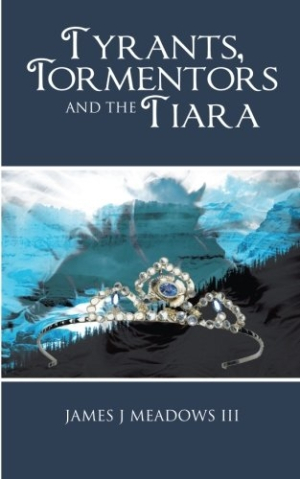
Tyrants, Tormentors and the Tiara
Backstories, humorous dialogue, and developed personalities humanize these four villainous protagonists.
Many fantasy readers know what’s going on with the villains in a story as the baddies antagonize the heroes, but what happens to the rogues after the hero defeats them? Of course, many die, but what happens to the despots that remain alive after the final battle? These questions are answered in James J. Meadows III’s brilliantly inventive and tightly plotted novel, Tyrants, Tormentors, and the Tiara.
Clement, Lillian, Darien, and Xanaphia, the titular tyrants, find themselves in exile. The just Queen Sylvia unites the countries they conquered and governs peacefully until enemies kidnap her. The abductors covet the queen’s crown, which grants its possessor great power. When male magic users Darien and Clement hear about Sylvia’s abduction, they reluctantly team up with female mages Lillian and Xanaphia. Each member of the quartet wishes to slay the queen and get the tiara for him or herself. However, the group’s mission soon changes as they realize that they may be better off keeping Sylvia alive.
The four deposed rulers all represent well-developed characters with multifaceted backstories. As natural born leaders, they don’t take kindly to suggestions, particularly those from former enemies. It is a pleasure to see four strong-willed, self-possessed protagonists. Each character is adept at performing a different type of spell. Old rivalries further round out their personalities. Despite the treachery they committed as dictators, they are easy to root for because the author does an excellent job of humanizing them.
Often, the dialogue is funny, such as in the following scene where the characters bicker:
“Great!” Lillian [said to Darien]. “You’re exactly who Clement needs. You couldn’t be stealthy if your life depended on it. Which, by the way, it will!”
“Fine,” Darien said. “When [the evil overlord] takes over the world, you can sit around thinking about how right you were. Maybe [he] needs concubines.”
…
“Wait a minute,” Darien asked. “Who invited you along?”
“Clement did,” Lillian answered. … “You said I could tag along and watch you get killed. Sounds like fun.”
The author develops his version of magic well; it is necessary for a spell to hit one’s opponent directly in order for the enchantment to be effective. Sorcery is cast using mystical commands, such as “Otkreeteeyay!” and “Nasekamoye Ebevat!” Because the effects of the power are not explained prior to saying the words, coupled with the fact that the characters usually speak standard English, these spells come across as nonsense words, instead of the powerful invocations they are supposed to be.
With its fully developed characters and magic, the story moves quickly. In addition to the viewpoints of the quartet, the audience also gets the queen’s perspective, which heightens the suspense considerably. Among the outside dangers and the conflicting relationships in the foursome, there is enough action to keep the audience engrossed. Indeed, sometimes there is so much going on that the backstories, each of which is interesting enough to merit its own book, get sidelined into summary paragraphs. The result of cramming this story full of fascinating history is that this novel feels more like a sequel.
Besides having ample material for many books, this novel could have used one more proofreading before going to print. There is much incorrect capitalization and punctuation during dialogue, along with frequent missing punctuation marks. Fantasy lovers of any age will enjoy this exciting novel.
Reviewed by
Jill Allen
Disclosure: This article is not an endorsement, but a review. The publisher of this book provided free copies of the book and paid a small fee to have their book reviewed by a professional reviewer. Foreword Reviews and Clarion Reviews make no guarantee that the publisher will receive a positive review. Foreword Magazine, Inc. is disclosing this in accordance with the Federal Trade Commission’s 16 CFR, Part 255.
